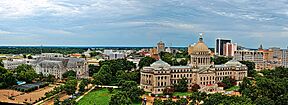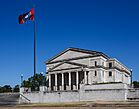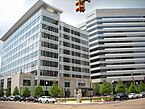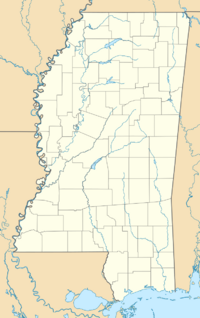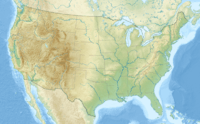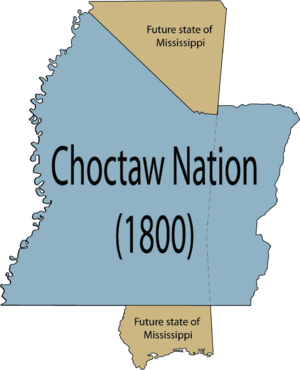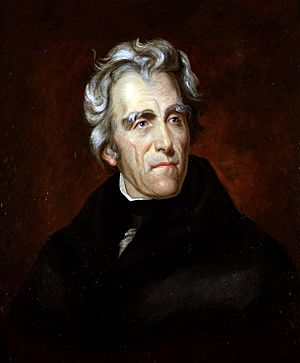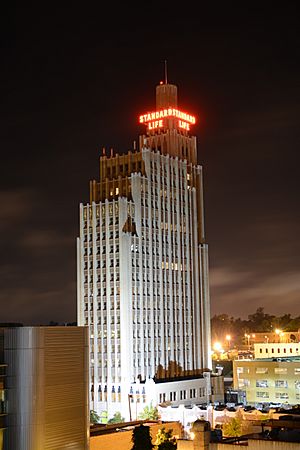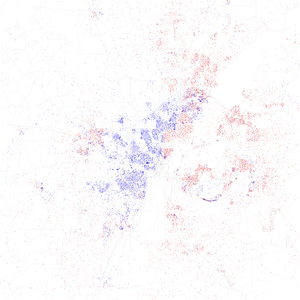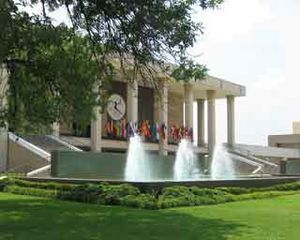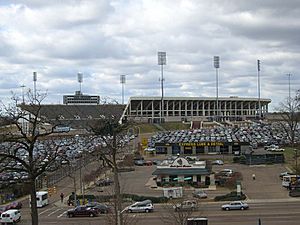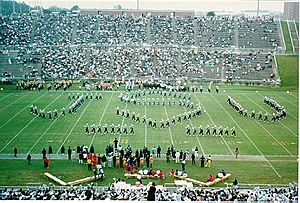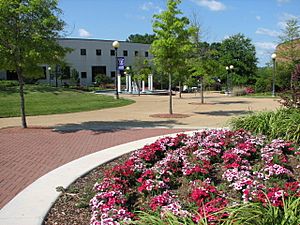Jackson, Mississippi facts for kids
Quick facts for kids
Jackson
|
|||||
|---|---|---|---|---|---|
|
Downtown Jackson
Lamar Life Building
Supreme Court of Mississippi
One Jackson Place
|
|||||
|
|||||
| Motto(s):
The City with Soul
|
|||||
| Country | |||||
| State | |||||
| Counties | Hinds, Madison, Rankin | ||||
| Incorporated | 1822 | ||||
| Named for | Andrew Jackson | ||||
| Government | |||||
| • Type | Mayor–Council | ||||
| Area | |||||
| • State capital city | 113.85 sq mi (294.88 km2) | ||||
| • Land | 111.72 sq mi (289.34 km2) | ||||
| • Water | 2.14 sq mi (5.53 km2) | ||||
| Elevation | 361 ft (110 m) | ||||
| Population
(2020)
|
|||||
| • State capital city | 153,701 | ||||
| • Rank | US: 170th | ||||
| • Density | 1,375.82/sq mi (531.21/km2) | ||||
| • Urban | 347,693 (US: 118th) | ||||
| • Urban density | 1,466.1/sq mi (566.1/km2) | ||||
| • Metro | 591,978 (US: 99th) | ||||
| Demonym(s) | Jacksonian | ||||
| GDP | |||||
| • Metro | .054 billion (2023) | ||||
| Time zone | UTC−6 (CST) | ||||
| • Summer (DST) | UTC−5 (CDT) | ||||
| ZIP Codes |
39201-39213, 39215-39218, 39225, 39232, 39236, 39250, 39269, 39271-39272, 39282-39284, 39286, 39288-39289, 39296, 39298
|
||||
| Area codes | 601/769 | ||||
| FIPS code | 28-36000 | ||||
| GNIS feature ID | 2404779 | ||||
| For additional city data see City-Data | |||||
Jackson is the capital of and the most populous city in the U.S. state of Mississippi. Along with Raymond, Jackson is one of two county seats for Hinds County. The city had a population of 153,701 at the 2020 census, a significant decline from 173,514, or 11.42%, since the 2010 census, representing the largest decline in population during the decade of any major U.S. city. Jackson is the anchor for the Jackson metropolitan statistical area, the largest metropolitan area located entirely in the state and the tenth-largest urban area in the Deep South. With a 2020 population of nearly 600,000, metropolitan Jackson is home to over one-fifth of Mississippi's population. The city sits on the Pearl River and is located in the greater Jackson Prairie region of Mississippi. Jackson is the only city in Mississippi with a population exceeding 100,000 people.
Founded in 1821 as new state capital for Mississippi, Jackson is named after General Andrew Jackson, a war hero in the Battle of New Orleans during the War of 1812 and subsequently the seventh U.S. president. Following the Battle of Vicksburg, which was fought near Jackson during the American Civil War in 1863, Union forces commanded by General William Tecumseh Sherman launched the siege of Jackson and set the city on fire.
During the 1920s, Jackson surpassed Meridian to become the most populous city in the state following a speculative natural gas boom in the region. The current slogan for the city is "The City with Soul". It has had numerous musicians prominent in blues, gospel, folk, and jazz. The city is located in the deep south halfway between Memphis and New Orleans on Interstate 55 and Dallas and Atlanta on Interstate 20.
The city has a number of museums and cultural institutions, including the Mississippi Children's Museum, Mississippi Museum of Natural Science, Mississippi Civil Rights Museum, Mississippi Museum of Art, Old Capital Museum, Museum of Mississippi History. Other notable locations are the Mississippi Coliseum and the Mississippi Veterans Memorial Stadium, home of the Jackson State Tigers football team.
In 2020, the Jackson metropolitan area held a GDP of 30 billion dollars, accounting for 29% of the state's total GDP of 104.1 billion dollars.
Contents
History
American Indians
The region that is now the city of Jackson was historically part of the large territory occupied by the Choctaw Nation, the historic culture of the Muskogean-speaking indigenous peoples who had inhabited the area for thousands of years before European encounter. The Choctaw name for the locale was "Chisha Foka". The area now called Jackson was obtained by the United States under the terms of the Treaty of Doak's Stand in 1820, by which the Choctaw ceded some of their land. After the treaty was ratified, European-American settlers began to move into the area, so many that they encroached on remaining Choctaw communal lands.
Under pressure from the U.S. government, the Choctaw Native Americans agreed to removal after 1830 from all their lands east of the Mississippi River under the terms of several treaties. Although most of the Choctaw moved to Indian Territory in present-day Oklahoma, along with the other of the Five Civilized Tribes, a significant number chose to stay in their homeland, citing Article XIV of the Treaty of Dancing Rabbit Creek. They gave up their tribal membership and became state and United States citizens at the time. Today, most Choctaw in Mississippi have reorganized and are part of the federally recognized Mississippi Band of Choctaw Indians. They live in several majority-Indian communities located throughout the state. The largest community is located in Choctaw 100 mi (160 km) northeast of Jackson.
Founding and antebellum period (to 1860)
Located on the historic Natchez Trace trade route, created by Native Americans and used by European-American settlers, and the Pearl River, the city's first European-American settler was Louis LeFleur, a French Canadian trader. The village became known as LeFleur's Bluff. During the late 18th century and early 19th century, this site had a trading post. It was connected to markets in Tennessee. Tennessee soldiers returning from the military campaigns near New Orleans in 1815 built a public road that connected Lake Pontchartrain in Louisiana to this district. A United States treaty with the Choctaw, the Treaty of Doak's Stand in 1820, formally opened the area for non-Native American settlers.
LeFleur's Bluff was developed when it was chosen as the site for the new state's capital city. The Mississippi General Assembly decided in 1821 that the state needed a centrally located capital (the legislature was then located in Natchez). They commissioned Thomas Hinds, James Patton, and William Lattimore to look for a suitable site. The absolute center of the state was a swamp, so the group had to widen their search.
After surveying areas north and east of Jackson, they proceeded southwest along the Pearl River until they reached LeFleur's Bluff in today's Hinds County. Their report to the General Assembly stated that this location had beautiful and healthful surroundings, good water, abundant timber, navigable waters, and proximity to the trading route Natchez Trace. The Assembly passed an act on November 28, 1821, authorizing the site as the permanent seat of the government of the state of Mississippi. On the same day, it passed a resolution to instruct the Washington delegation to press Congress for a donation of public lands on the river for the purpose of improved navigation to the Gulf of Mexico. One Whig politician lamented the new capital as a "serious violation of principle" because it was not at the absolute center of the state.
The capital was named for General Andrew Jackson, to honor his (January 1815) victory at the Battle of New Orleans during the War of 1812. He was later elected as the seventh President of the United States.
The city of Jackson was originally planned, in April 1822, by Peter Aaron Van Dorn in a "checkerboard" pattern advocated by Thomas Jefferson. City blocks alternated with parks and other open spaces. Over time, many of the park squares have been developed rather than maintained as green space. The state legislature first met in Jackson on December 23, 1822. In 1839, the Mississippi Legislature passed the first state law in the U.S. to permit married women to own and administer their own property.
Jackson was connected by public road to Vicksburg and Clinton in 1826. Jackson was first connected by railroad to other cities in 1840. An 1844 map shows Jackson linked by an east-west rail line running between Vicksburg, Raymond, and Brandon. Unlike Vicksburg, Greenville, and Natchez, Jackson is not located on the Mississippi River, and it did not develop during the antebellum era as those cities did from major river commerce. Construction of railroad lines to the city sparked its growth in the decades following the American Civil War.
American Civil War and late nineteenth century (1861–1900)

Despite its small population, during the Civil War, Jackson became a strategic center of manufacturing for the Confederate States of America. In 1863, during the campaign which ended in the capture of Vicksburg, Union forces captured Jackson during two battles—once before the fall of Vicksburg and once after the fall of Vicksburg.
On May 13, 1863, Union forces won the first Battle of Jackson, forcing Confederate forces to flee northward towards Canton. On May 15, Union troops under the command of William Tecumseh Sherman burned and looted key facilities in Jackson, a strategic manufacturing and railroad center for the Confederacy. After driving the Confederate forces out of Jackson, Union forces turned west and engaged the Vicksburg defenders at the Battle of Champion Hill in nearby Edwards. The Union forces began their siege of Vicksburg soon after their victory at Champion Hill. Confederate forces began to reassemble in Jackson in preparation for an attempt to break through the Union lines surrounding Vicksburg and end the siege. The Confederate forces in Jackson built defensive fortifications encircling the city while preparing to march west to Vicksburg.
Confederate forces marched out of Jackson in early July 1863 to break the siege of Vicksburg. But, unknown to them, Vicksburg had already surrendered on July 4, 1863. General Ulysses S. Grant dispatched General Sherman to meet the Confederate forces heading west from Jackson. Upon learning that Vicksburg had already surrendered, the Confederates retreated into Jackson. Union forces began the Siege of Jackson, which lasted for approximately one week. Union forces encircled the city and began an artillery bombardment. One of the Union artillery emplacements has been preserved on the grounds of the University of Mississippi Medical Center in Jackson. Another Federal position is preserved on the campus of Millsaps College. John C. Breckinridge, former United States Vice President, served as one of the Confederate generals defending Jackson. On July 16, 1863, Confederate forces slipped out of Jackson during the night and retreated across the Pearl River.
Union forces completely burned the city after its capture this second time. The city was called "Chimneyville" because only the chimneys of houses were left standing. The northern line of Confederate defenses in Jackson during the siege was located along a road near downtown Jackson, now known as Fortification Street.
Because of the siege and following destruction, few antebellum structures have survived in Jackson. The Governor's Mansion, built in 1842, served as Sherman's headquarters and has been preserved. Another is the Old Capitol building, which served as the home of the Mississippi state legislature from 1839 to 1903. The Mississippi legislature passed the ordinance of secession from the Union on January 9, 1861 there, becoming the second state to secede from the United States. The Jackson City Hall, built in 1846 for less than $8,000, also survived. It is said that Sherman, a Mason, spared it because it housed a Masonic Lodge, though a more likely reason is that it housed an army hospital.
During Reconstruction, Mississippi had considerable insurgent action, as whites struggled to maintain supremacy. In 1875 the Red Shirts were formed, one of a second wave of insurgent paramilitary organizations that essentially operated as "the military arm of the Democratic Party" to take back political power from the Republicans and to drive blacks from the polls. Democrats regained control of the state legislature in 1876. The constitutional convention of 1890, which produced Mississippi's Constitution of 1890, was also held at the capitol.
This was the first of new constitutions or amendments ratified in each Southern state through 1908 that effectively disenfranchised most African Americans and many poor whites, through provisions making voter registration more difficult: such as poll taxes, residency requirements, and literacy tests. These provisions survived a Supreme Court challenge in 1898. As 20th-century Supreme Court decisions later ruled such provisions were unconstitutional, Mississippi and other Southern states rapidly devised new methods to continue disfranchisement of most blacks, who comprised a majority in the state until the 1930s. Their exclusion from politics was maintained into the late 1960s.
The economic recovery from the Civil War was slow through the start of the 20th century, but there were some developments in transportation. In 1871, the city introduced mule-drawn streetcars which ran on State Street, which were replaced by electric ones in 1899.
The so-called New Capitol replaced the older structure upon its completion in 1903. Today the Old Capitol is operated as a historical museum.
Early twentieth century (1901–1960)
Author Eudora Welty was born in Jackson in 1909, lived most of her life in the Belhaven section of the city, and died there in 2001. Her memoir of development as a writer, One Writer's Beginnings (1984), presented a picture of the city in the early twentieth century. She won the Pulitzer Prize in 1973 for her novel, The Optimist's Daughter, and is best known for her novels and short stories. The main Jackson Public Library was named in her honor, and her home has been designated as a National Historic Landmark.
Richard Wright, a highly acclaimed African-American author, lived in Jackson as an adolescent and young man in the 1910s and 1920s. He related his experience in his memoir Black Boy (1945). He described the harsh and largely terror-filled life most African Americans experienced in the South and Northern ghettos such as Chicago under segregation in the early twentieth century.
Jackson had significant growth in the early twentieth century, which produced dramatic changes in the city's skyline. Jackson's new Union Station downtown reflected the city's service by multiple rail lines, including the Illinois Central. The railroads were among the new work opportunities for African Americans, who moved into the city from rural areas for such industrial-type jobs.
Across the street, the new, luxurious King Edward Hotel opened its doors in 1923, having been built according to a design by New Orleans architect William T. Nolan. It became a center for prestigious events held by Jackson society and Mississippi politicians. Nearby, the 18-story Standard Life Building, designed in 1929 by Claude Lindsley, was the largest reinforced concrete structure in the world upon its completion.
Jackson's economic growth was further stimulated in the 1930s by the discovery of natural gas fields nearby. Speculators had begun searching for oil and natural gas in Jackson beginning in 1920. The initial drilling attempts came up empty. This failure did not stop Ella Render from obtaining a lease from the state's insane asylum to begin a well on its grounds in 1924, where he found natural gas. (Render eventually lost the rights when courts determined that the asylum did not have the right to lease the state's property.) Businessmen jumped on the opportunity and dug wells in the Jackson area. The continued success of these ventures attracted further investment. By 1930, there were 14 derricks in the Jackson skyline.
This enthusiasm was subdued when the first wells failed to produce oil of a sufficiently high gravity for commercial success. The barrels of oil had considerable amounts of salt water, which lessened the quality. The governor's prediction is wrong in hindsight, but the oil and natural gas industry did provide an economic boost for the city and state. The effects of the Great Depression were mitigated by the industry's success. At its height in 1934, there were 113 producing wells in the state. The overwhelming majority were closed by 1955.
Due to provisions in the federal Rivers and Harbors Act, on October 25, 1930 city leaders met with U.S. Army engineers to ask for federal help to alleviate Jackson flooding. J.J. Halbert, city engineer, proposed a straightening and dredging of the Pearl River below Jackson.
Jackson's Gold Coast
During Mississippi's extended Prohibition period, from the 1920s until the 1960s, illegal drinking and gambling casinos flourished on the east side of the Pearl River, in Flowood along the original U.S. Route 80 just across from the city of Jackson. Those illegal casinos, bootleg liquor stores, and nightclubs made up the Gold Coast, a strip of mostly black-market businesses that operated for decades along Flowood Road. Although outside the law, the Gold Coast was a thriving center of nightlife and music, with many local blues musicians appearing regularly in the clubs.
The Gold Coast declined and businesses disappeared after Mississippi's prohibition laws were repealed in 1966, allowing Hinds County, including Jackson, to go "wet". In addition, integration drew off business from establishments that earlier had catered to African Americans, such as the Summers Hotel. When it opened in 1943 on Pearl Street, it was one of two hotels in the city that served black clients. For years its Subway Lounge was a prime performance spot for black musicians playing jazz and blues.
In another major change, in 1990 the state approved gaming on riverboats. Numerous casinos have been developed on riverboats, mostly in Mississippi Delta towns such as Tunica Resorts, Greenville and Vicksburg and Biloxi on the Gulf Coast. Before the damage and losses due to Hurricane Katrina in 2005, the state ranked second nationally in gambling revenues.
World War II and later development
During World War II, Hawkins Field in northwest Jackson was developed as a major airbase. Among other facilities and units, the Royal Netherlands Military Flying School was established there, after Nazi Germany occupied the Netherlands. From 1941, the base trained all Dutch military aircrews.
In 1949, the poet Margaret Walker began teaching at Jackson State University, a historically black college. She taught there until 1979, and founded the university's Center for African-American Studies. Her poetry collection won a Yale Younger Poets Prize. Her second novel, Jubilee (1966), is considered a major work of African-American literature. She has influenced many younger writers.
Civil Rights Movement in Jackson
The Civil Rights Movement had been active for decades, particularly mounting legal challenges to Mississippi's constitution and laws that disfranchised blacks. Beginning in 1960, Jackson as the state capital became the site for dramatic non-violent protests in a new phase of activism that brought in a wide variety of participants in the performance of mass demonstrations.
In 1960, the Census Bureau reported Jackson's population as 64.3% white and 35.7% black. At the time, public facilities were segregated and Jim Crow was in effect. Efforts to desegregate Jackson facilities began when nine Tougaloo College students tried to read books in the "white only" public library and were arrested. Founded as a historically black college (HBCU) by the American Missionary Association after the Civil War, Tougaloo College helped organize both black and white students of the region to work together for civil rights. It created partnerships with the neighboring mostly white Millsaps College to work with student activists. It has been recognized as a site on the "Civil Rights Trail" by the National Park Service.
The mass demonstrations of the 1960s were initiated with the arrival of more than 300 Freedom Riders on May 24, 1961. They were arrested in Jackson for disturbing the peace after they disembarked from their interstate buses. The interracial teams rode the buses from Washington, DC and sat together to demonstrate against segregation on public transportation, as the Constitution provides for unrestricted public transportation. Although the Freedom Riders had intended New Orleans, Louisiana as their final destination, Jackson was the farthest that any managed to travel. New participants kept joining the movement, as they intended to fill the jails in Jackson with their protest. The riders had encountered extreme violence along the way, including a bus burning and physical assaults. They attracted national media attention to the struggle for constitutional rights.
After the Freedom Rides, students and activists of the Freedom Movement launched a series of merchant boycotts, sit-ins and protest marches, from 1961 to 1963. Businesses discriminated against black customers. For instance, at the time, department stores did not hire black salesclerks or allow black customers to use their fitting rooms to try on clothes, or lunch counters for meals while in the store, but they wanted them to shop in their stores.
In Jackson, shortly after midnight on June 12, 1963, Medgar Evers, civil rights activist and leader of the Mississippi chapter of the NAACP, was assassinated by Byron De La Beckwith, a white supremacist associated with the White Citizens' Council. Thousands marched in Evers' funeral procession to protest the killing. Two trials at the time both resulted in hung juries. A portion of U.S. Highway 49, all of Delta Drive, a library, the central post office for the city, and Jackson-Evers International Airport were named in honor of Medgar Evers. In 1994, prosecutors Ed Peters and Bobby DeLaughter finally obtained a murder conviction in a state trial of De La Beckwith based on new evidence.
During 1963 and 1964, civil rights organizers gathered local residents for voter education and voter registration. Blacks had been essentially disfranchised since 1890. In a pilot project in 1963, activists rapidly registered 80,000 voters across the state, demonstrating the desire of African Americans to vote. In 1964 they created the Mississippi Freedom Democratic Party as an alternative to the all-white state Democratic Party, and sent an alternate slate of candidates to the national Democratic Party convention in Atlantic City, New Jersey that year.
Segregation and the disfranchisement of African Americans gradually ended after the Civil Rights Movement gained Congressional passage of the Civil Rights Act of 1964 and Voting Rights Act of 1965. In June 1966, Jackson was the terminus of the James Meredith March, organized by James Meredith, the first African American to enroll at the University of Mississippi. The march, which began in Memphis, Tennessee, was an attempt to garner support for full implementation of civil rights in practice, following the legislation. It was accompanied by a new drive to register African Americans to vote in Mississippi. In this latter goal, it succeeded in registering between 2,500 and 3,000 black Mississippians to vote. The march ended on June 26 after Meredith, who had been wounded by a sniper's bullet earlier on the march, addressed a large rally of some 15,000 people in Jackson.
In September 1967 a Ku Klux Klan chapter bombed the synagogue of the Beth Israel Congregation in Jackson, and in November bombed the house of its rabbi, Dr. Perry Nussbaum. He and his congregation had supported civil rights.
Gradually the old barriers came down. Since that period, both whites and African Americans in the state have had a consistently high rate of voter registration and turnout. Following the decades of the Great Migration, when more than one million blacks left the rural South, since the 1930s the state has been majority white in total population. African Americans are a majority in the city of Jackson, although the metropolitan area is majority white. They are also a majority in several cities and counties of the Mississippi Delta, which are included in the 2nd congressional district. The other three congressional districts are majority white.
Mid-1960s to present
The first successful cadaveric lung transplant was performed at the University of Mississippi Medical Center in Jackson in June 1963 by Dr. James Hardy. Hardy transplanted the cadaveric lung into a patient suffering from lung cancer. The patient survived for eighteen days before dying of kidney failure.
In 1966 it was estimated that recurring flood damage at Jackson from the Pearl River averaged nearly a million dollars per year. The U.S. Army Corp of Engineers spent $6.8 million on the levees and new channel in 1966 prior to the project completion with the aim to prevent a flood equal to the Dec. 1961 event plus an additional foot.
Since 1968, Jackson has been the home of Malaco Records, one of the leading record companies for gospel, blues and soul music in the United States. In January 1973, Paul Simon recorded the songs "Learn How To Fall" and "Take Me To the Mardi Gras", found on the album There Goes Rhymin' Simon, in Jackson at the Malaco Recording Studios. Many well-known Southern artists recorded on the album including the Muscle Shoals Rhythm Section (David Hood, Jimmy Johnson, Roger Hawkins, Barry Beckett); Carson Whitsett, the Onward Brass Band from New Orleans, and others. The label has recorded many leading soul and blues artists, including Bobby Bland, ZZ Hill, Latimore, Shirley Brown, Denise LaSalle and Tyrone Davis.
On May 15, 1970 police killed two students and wounded 12 at Jackson State University (then called Jackson State College) after a protest of the Vietnam War included students' overturning and burning some cars. These killings occurred eleven days after the National Guard killed four students in an anti-war protest at Kent State University in Ohio, and were part of national social unrest. Newsweek cited the Jackson State killings in its issue of May 18 when it suggested that U.S. President Richard Nixon faced a new home front.
As Jackson has become the medical and legal center of the state, it has attracted Jewish professionals in both fields. Since the late 20th century, it has developed the largest Jewish community in the state.
In 1997, Harvey Johnson, Jr. was elected as Jackson's first African-American mayor. During his term, he proposed the development of a convention center to attract more business to the city. In 2004, during his second term, 66 percent of the voters passed a referendum for a tax to build the Convention Center.
Mayor Johnson was replaced by Frank Melton on July 4, 2005. Melton generated controversy through his unconventional behavior, which included acting as a law enforcement officer.
In 2007 Hinds County sheriff Malcolm McMillin was also appointed as the new police chief in Jackson, setting a historic precedent. McMillin was both the county sheriff and city police chief until 2009, when he stepped down due to the disagreements with the mayor. Mayor Frank Melton died in May 2009 and City Councilman Leslie McLemore served as acting mayor of Jackson until July 2009, when former Mayor Harvey Johnson was elected and assumed the position.
On March 18, 2013, a severe hailstorm hit the Jackson metro area. The hail caused major damage to roofs, vehicles, and siding damage to many homes. Hail ranged in size from golfball to softball. There were more than 40,000 hailstorm claims of homeowner and automobile damage.
On July 1, 2013, Chokwe Lumumba was sworn into office as mayor of the city. After eight months in office, Lumumba died on February 25, 2014. Lumumba was a controversial figure due to his prior membership in the Republic of New Africa, as well as being a co-founder of the National Coalition of Blacks for Reparations in America. Lumumba's son, Chokwe Antar Lumumba, ran for the mayoral seat following his father's death, but lost to Councillor Tony Yarber on April 22, 2014.
In 2013, Jackson was named as one of the top 10 friendliest cities in the United States by CN Traveler. The capital city was tied with Natchez as Number 7. The city was noticed for friendly people, great food, and green and pretty public places.
Geography

Jackson is located on the Pearl River, and is served by the Ross Barnett Reservoir, which forms a section of the Pearl River and is located northeast of Jackson on the border between Madison and Rankin counties. A tiny portion of the city containing Tougaloo College lies in Madison County, bounded on the west by I-220 and on the east by US 51 and I-55. A second portion of the city is located in Rankin County. In the 2000 census, only 1,533 of the city's residents lived in Madison County. Although no Jackson residents lived in the Rankin County portion in 2000, that figure had risen to 172 by 2006.
According to the United States Census Bureau, the city has a total area of 106.8 square miles (277 km2), of which, 104.9 square miles (272 km2) is land, and 1.9 square miles (4.9 km2), or 1.80% of the total, is water.
Major highways
Geology
Jackson sits atop the Jackson Volcano and is the only capital city in the United States to have this feature. The peak of the volcano is located 2,900 feet (880 m) directly below the Mississippi Coliseum. The municipality is drained by the Big Black River tributaries on the west and the Pearl River on the east which is 150 feet (46 m) higher than the Big Black River near Canton. The artesian ground water flow is not as extensive in Jackson for this reason. The first large scale well was drilled in the city in 1896 and the city water supply has relied on surface water resources.
Climate
Jackson is located in the humid subtropical climate zone (Köppen Cfa). Rain occurs throughout the year, though the winter and spring are the wettest seasons, and the late summer and early autumn is usually the driest time of the year. Snow is rare, and accumulation very seldom lasts more than a day. The mean annual precipitation is about 51 inches. Much of Jackson's rainfall occurs during thunderstorms. Thunder is heard on roughly 70 days each year. Jackson lies in a region prone to severe thunderstorms which can produce large hail, damaging winds and tornadoes. Among the most notable tornado events was the F5 Candlestick Park Tornado on March 3, 1966 which destroyed the shopping center of the same name and surrounding businesses and residential areas, killing 19 in South Jackson.
The record low temperature is −5 °F (−21 °C), set on January 27, 1940, and the record high is 107 °F (42 °C), recorded as recently as August 30, 2000.
| Climate data for Jackson–Evers International Airport, Mississippi (1981–2010 normals, extremes 1896–present) | |||||||||||||
|---|---|---|---|---|---|---|---|---|---|---|---|---|---|
| Month | Jan | Feb | Mar | Apr | May | Jun | Jul | Aug | Sep | Oct | Nov | Dec | Year |
| Record high °F (°C) | 85 (29) |
89 (32) |
95 (35) |
94 (34) |
100 (38) |
105 (41) |
107 (42) |
107 (42) |
107 (42) |
98 (37) |
89 (32) |
84 (29) |
107 (42) |
| Mean daily maximum °F (°C) | 56.1 (13.4) |
60.5 (15.8) |
68.5 (20.3) |
75.9 (24.4) |
83.1 (28.4) |
89.5 (31.9) |
91.6 (33.1) |
91.6 (33.1) |
86.7 (30.4) |
77.2 (25.1) |
67.4 (19.7) |
58.2 (14.6) |
75.5 (24.2) |
| Mean daily minimum °F (°C) | 35.3 (1.8) |
38.5 (3.6) |
45.3 (7.4) |
52.2 (11.2) |
61.6 (16.4) |
68.6 (20.3) |
71.6 (22.0) |
70.9 (21.6) |
64.6 (18.1) |
53.1 (11.7) |
44.0 (6.7) |
37.3 (2.9) |
53.6 (12.0) |
| Record low °F (°C) | −5 (−21) |
1 (−17) |
15 (−9) |
27 (−3) |
36 (2) |
47 (8) |
51 (11) |
54 (12) |
35 (2) |
26 (−3) |
15 (−9) |
4 (−16) |
−5 (−21) |
| Average precipitation inches (mm) | 4.97 (126) |
4.76 (121) |
5.04 (128) |
4.96 (126) |
4.38 (111) |
4.12 (105) |
4.81 (122) |
4.24 (108) |
3.03 (77) |
3.92 (100) |
4.76 (121) |
5.15 (131) |
54.14 (1,376) |
| Average precipitation days (≥ 0.01 in) | 9.8 | 9.8 | 9.4 | 7.9 | 8.9 | 9.4 | 10.7 | 9.9 | 7.0 | 7.6 | 8.6 | 9.6 | 108.6 |
| Average relative humidity (%) | 76.2 | 73.2 | 71.1 | 71.5 | 73.8 | 73.6 | 76.9 | 77.0 | 77.3 | 74.8 | 75.9 | 76.5 | 74.8 |
| Mean monthly sunshine hours | 154.5 | 165.3 | 223.5 | 251.1 | 276.2 | 298.5 | 283.4 | 273.1 | 232.7 | 235.2 | 174.0 | 152.1 | 2,719.6 |
| Percent possible sunshine | 48 | 53 | 60 | 65 | 65 | 70 | 65 | 66 | 63 | 67 | 55 | 49 | 61 |
| Source: NOAA (relative humidity and sun 1961–1990) | |||||||||||||
Demographics
| Historical population | |||
|---|---|---|---|
| Census | Pop. | %± | |
| 1850 | 1,881 | — | |
| 1860 | 3,191 | 69.6% | |
| 1870 | 4,234 | 32.7% | |
| 1880 | 5,204 | 22.9% | |
| 1890 | 5,920 | 13.8% | |
| 1900 | 7,816 | 32.0% | |
| 1910 | 21,262 | 172.0% | |
| 1920 | 22,817 | 7.3% | |
| 1930 | 48,282 | 111.6% | |
| 1940 | 62,107 | 28.6% | |
| 1950 | 98,271 | 58.2% | |
| 1960 | 144,422 | 47.0% | |
| 1970 | 153,968 | 6.6% | |
| 1980 | 202,895 | 31.8% | |
| 1990 | 196,637 | −3.1% | |
| 2000 | 184,286 | −6.3% | |
| 2010 | 173,514 | −5.8% | |
| 2020 | 153,701 | −11.4% | |
| 2022 (est.) | 145,995 | −15.9% | |
| U.S. Decennial Census 2020 census |
|||
Jackson remained a small town for much of the 19th century. Before the American Civil War, Jackson's population remained small, particularly in contrast to the river towns along the commerce-laden Mississippi River. Despite the city's status as the state capital, the 1850 census counted only 1,881 residents, excluding slaves, which were not returned separately.
By 1900 the population of Jackson was still less than 8,000. Although it expanded rapidly, during this period Meridian became Mississippi's largest city, based on trade, manufacturing, and access to transportation via railroad and highway.
In the early 20th century, Jackson had its largest rates of growth but ranked second to Meridian in Mississippi. By 1944, Jackson's population had risen to some 70,000 inhabitants, and it became the largest city in the state. For several decades, Jackson had the most thriving business districts and the largest public school system in Mississippi. It achieved its peak population in the 1980 census of more than 200,000 residents in the city. Since 1980, Jackson has declined in population due to several factors while its surrounding suburban population has increased.
Race and ethnicity
| Race / Ethnicity (NH = Non-Hispanic) | Pop 2000 | Pop 2010 | Pop 2020 | % 2000 | % 2010 | % 2020 |
|---|---|---|---|---|---|---|
| White alone (NH) | 50,679 | 31,194 | 25,424 | 27.50% | 17.98% | 16.54% |
| Black or African American alone (NH) | 129,609 | 137,265 | 120,727 | 70.34% | 79.11% | 78.55% |
| Native American or Alaska Native alone (NH) | 213 | 232 | 237 | 0.12% | 0.13% | 0.15% |
| Asian alone (NH) | 1,045 | 660 | 751 | 0.57% | 0.38% | 0.49% |
| Pacific Islander alone (NH) | 18 | 18 | 30 | 0.01% | 0.01% | 0.02% |
| Some Other Race alone (NH) | 128 | 99 | 362 | 0.07% | 0.06% | 0.24% |
| Mixed Race or Multi-Racial (NH) | 1,113 | 1,323 | 2,951 | 0.60% | 0.76% | 1.92% |
| Hispanic or Latino (any race) | 1,451 | 2,723 | 3,219 | 0.79% | 1.57% | 2.09% |
| Total | 184,256 | 173,514 | 153,701 | 100.00% | 100.00% | 100.00% |
According to the 2010 census, the racial and ethnic makeup of the city was predominantly Black and African American, and non-Hispanic white; in 2020, they remained the largest racial and ethnic composition for the city. This Hispanic or Latino population is the fastest growing racial and ethnic group in the city.
Income
According to census statistics in 2000, the median income for a household in the city was $30,414, and the median income for a family was $36,003. Males had a median income of $29,166 versus $23,328 for females. The per capita income for the city was $17,116. About 19.6% of families and 23.5% of the population were below the poverty line, including 33.7% of those under age 18 and 15.7% of those age 65 or over. At the publication of the 2020 American Community Survey, the city's median household income increased to $35,070; families had a median income of $44,348, married-couple families $74,893, and non-families $22,061.
Economy
Jackson is home to several major industries; these include electrical equipment and machinery, processed food, and primary and fabricated metal products. The surrounding area supports the agricultural development of livestock, soybeans, cotton, and poultry.
According to the city's government, Jackson's top three employers are the University of Mississippi Medical Center, Jackson Public Schools, and Nissan North America as of 2020. Other notable corporations with a large presence in the city and area include C Spire and Amazon in nearby Madison County.
The city is home to Cooperation Jackson, which is an economic development vehicle for worker-owned cooperative business. The organization has led to the creation of several businesses including lawn care provider The Green Team, organic farm Freedom Farms, print shop The Center for Community Production, and The Balagoon Center, which is a cooperative business incubator.
Arts and culture
Jackson is home to a number of cultural and artistic attractions, including the following:
- Ballet Mississippi
- Celtic Heritage Society of Mississippi
- Crossroads Film Society and its annual Film Festival
- International Museum of Muslim Cultures
- Jackson State University Botanical Garden
- Jackson Zoo
- Kinetic Etchings Dance project
- Light and Glass Studio
- Margaret Walker Center
- Mississippi Agriculture and Forestry Museum
- Mississippi Arts Center
- Mississippi Chorus
- Mississippi Civil Rights Museum
- Mississippi Department of Archives and History, which contains the state archives and records
- Mississippi Heritage Trust
- Mississippi Hispanic Association
- Mississippi Metropolitan Ballet
- Mississippi Museum of Art
- Mississippi Opera
- Mississippi Shakespeare Festival
- Mississippi Symphony Orchestra (MSO), formerly the Jackson Symphony Orchestra, founded in 1944
- Municipal Art Gallery
- Museum of Mississippi History
- Mynelle Gardens
- New Stage Theatre
- Russell C. Davis Planetarium
- Smith-Robertson Museum and Cultural Center
- USA International Ballet Competition
Notable restaurants
- Bully's Restaurant
Sports
The city of Jackson and its metropolitan area are home to collegiate and semi-professional sports teams; Major League Baseball's Atlanta Braves minor affiliate, the Mississippi Braves, plays in the area. Mississippi Brilla of USL League Two also operates in the area. However, the Mississippi Braves will leave the city of Jackson and relocate their team at the end of the 2024 season. They will be relocating to Columbus, Georgia.
Education
Higher education
Jackson is home to the most collegiate institutions in Mississippi. Jackson State University is the largest collegiate institution in the city, fourth largest in the state, and the only doctoral-granting research institution based in its region.
Colleges and universities
Source:
- Jackson State University
- Tougaloo College
- Millsaps College
- Belhaven University
- University of Mississippi Medical Center
- Mississippi College School of Law
- Hinds Community College
Primary and secondary schools
Public schools
Jackson Public School District (JPS) operates 60 public schools. It is one of the largest school districts in the state with about 30,000 students in thirty-eight elementary schools, thirteen middle schools, seven high schools, and two special schools. Jackson Public Schools is the only urban school district in the state.
As of 2017[update] the public schools have few children who are middle or upper class, as 99% of the students in JPS qualify for free or reduced school lunches. In 2017 Susan Womack, president of the Parents for Public Schools Jackson (PPSJ) from 2000 to 2012, stated that middle to upper-class families in Jackson tended to leave public school after elementary school, with parents who remained in Jackson enrolling their children in private school, and those who wished to continue enrolling their children in public schools moving to Madison County. The PPSJ decided circa the mid-2000s that it was not feasible to encourage middle and upper-class parents to put their children in JPS schools.
The district's high schools include:
- Callaway High School
- Capital City Alternative School
- Career Development Center
- Forest Hill High School
- Jim Hill High School
- Lanier High School
- Murrah High School
- Provine High School
- Wingfield High School
While most of Jackson is in Jackson PSD, there are parts in Hinds County that are instead in Hinds County School District and in the Clinton Public School District. The Hinds County part is zoned to Terry High School in Terry. The portion of Jackson in Madison County is within the Madison County School District.
There are state-operated K-12 public schools for special purposes;
- Mississippi School for the Blind
- Mississippi School for the Deaf
Private schools
Private secondary schools include:
- Christ Missionary & Industrial (CM&I) College High School
- Hillcrest Christian School
- Jackson Academy
- Woodland Hills Academy (closed)
Some schools are in nearby municipalities:
- St. Andrew's Episcopal Middle and Upper School – North Campus (Ridgeland)
- Jackson Preparatory School (Flowood)
- The Veritas School (Ridgeland), closed
- St. Joseph Catholic School (Madison), of the Roman Catholic Diocese of Jackson
- Hartfield Academy (Flowood)
- Madison-Ridgeland Academy (Madison)
- Canton Academy (Canton)
- Tri-County Academy (Flora)
- Central Hinds Academy (Raymond)
- Rebul Academy (Learned)
- East Rankin Academy (Pelahatchie)
Private primary schools include:
- Jackson Academy
- First Presbyterian Day School
- Magnolia Speech School
- St. Andrew's Episcopal Lower School – South Campus
- St. Richard Catholic School
- St. Therese Catholic School
Public libraries
Jackson/Hinds Library System is the library system of Jackson.
Infrastructure
On March 27, 2015, Jackson Mayor Tony Yarber issued a state of emergency for transportation (potholes) and water infrastructure (breaks in water mains). The quality of Jackson's water infrastructure system decreased after the severe winter weather of 2014–2015. Jackson's office estimated the cost to fix the roads and water pipes at $750 million to $1 billion.
After issuing the state of emergency, the City of Jackson filed a letter of intent to Department of Health to borrow $2.5 million to repair broken water pipes. The Jackson City Council must approve the mayor's proposal. Additionally, Mayor Yarber asked for help from both FEMA and the state Governor's office.
Calling for a state of emergency increases the likelihood that the U.S. Department of Transportation would give the city money from a "quick release" funding account.
In late August 2022, the Pearl River overflowed, flooding much of the city and contaminating the water supply. Mayor Lumumba declared a state of emergency and shut down all businesses and schools.
Transportation
In 2015, 11 percent of the city of Jackson households lacked a car, which decreased to 7.6 percent in 2016. The national average was 8.7 percent in 2016. Jackson averaged 1.68 cars per household in 2016, compared to a national average of 1.8.
Jackson has an increasing number of bicycle lanes.
Jackson–Medgar Wiley Evers International Airport, the busiest commercial airport in Mississippi, is located east of city in Rankin County between Flowood and Pearl.
Jackson's Union Station serves Amtrak's daily overnight train, the City of New Orleans from Chicago to New Orleans. The intermodal station also serves Greyhound Lines intercity buses and is the primary station for Jackson's municipal buses.
The city is at the intersection of major Interstate and Federal Highways: north-south I-55, US 49, US 51, east–west I-20 and US 80.
Major highways
Notable people
See also
 In Spanish: Jackson (Misisipi) para niños
In Spanish: Jackson (Misisipi) para niños


